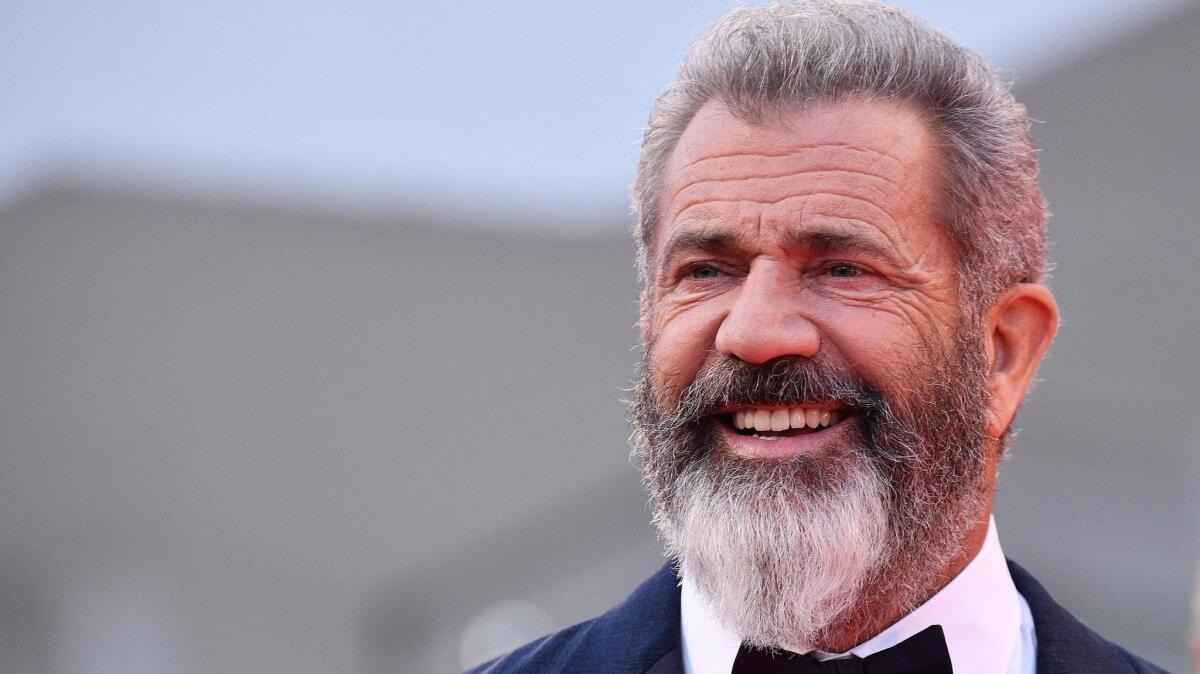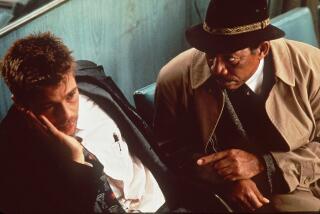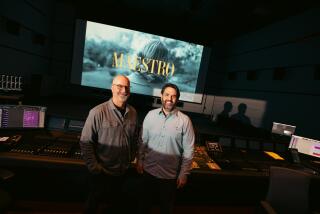How Mel Gibsonâs promising indie film went off the rails
When it was first published in 1998, âThe Professor and the Madmanâ by Simon Winchester was a book that seemed destined to become a prestige movie: it features a 19th century British setting, colorful characters and a story with cultural pedigree recounting the creation of the Oxford English Dictionary â the definitive resource for the English language.
The stars aligned, or so it seemed: Mel Gibson acquired the rights to the nonfiction book, and although it took nearly two decades to put the project together, the movie began filming last year in Dublin, Ireland, with a cast that includes Gibson as James Murray, the Scottish professor who took up the herculean task of compiling the dictionary, and Sean Penn as the mentally unstable American Civil War veteran who became his unexpected collaborator.
But what looked like a promising project has now capsized under an ugly legal dispute between star-producer Gibson and one of the production companies behind the movie. A series of fights over budgets, filming locations and final cut has raised questions about the future of the film, creating a cautionary tale about the challenges independent filmmakers face in trying to get their pet projects onto the big screen.
The case highlights how indie film production has become an increasingly perilous business, said Richard Marks, a partner at the Point Media, a Los Angeles entertainment law firm. âWhen you see independent movies, and you see all these producers [in the credits], you can see how risky it is and how many people it takes.â
The proliferation of producer credits â âProfessorâ features about 10 â means that there are more cooks in the kitchen, many of whom want a say in both the financial and creative aspects of production.
A war between producers lies at the heart of âThe Professor and the Madman.â On one side is Icon Productions, Mel Gibsonâs Santa Monica company behind such hits as âBraveheartâ and âThe Passion of the Christ.â It is squaring off against Voltage Pictures, the L.A. producer and film sales agent founded by Frenchman Nicolas Chartier. Gibson recently filed a breach of contract lawsuit in Los Angeles County Superior Court against Voltage, alleging it has failed to perform many of its fiduciary duties, including providing a final budget.
The suit also says Voltage has prevented the movie, directed by first-timer Farhad Safinia, from shooting crucial scenes on location in Oxford, England. As a result, principal photography on the movie remains incomplete, throwing the projectâs future into doubt.
Winchester, the author, isnât involved with the suit but is siding with Icon. âI donât blame them at all. Voltage has behaved pretty shabbily,â Winchester said in an interview.
The British-born writer, who did not have a formal role in the production, said he was âmore amused than appalledâ by the legal dispute. âI was a young man when people first started saying to me âthis would be a great movieâ,â he said. âI sometimes think Iâll be in my grave before it gets made.â
Voltage has denied the allegations, saying in a statement that it âhad sincerely hoped to have an excellent relationship with Mel Gibson and his company on âThe Professor and The Madman,â but Mr. Gibson and the filmâs director consistently failed to live up to their professional and contractual responsibilities to Voltage. Voltage intends to vigorously defend itself in the lawsuit, and we are confident Voltage will ultimately be fully vindicated.â
The company noted that its films have won multiple Oscars, including a best-picture win for âThe Hurt Lockerâ in 2010.

Although legal disputes are common in the indie film world, they often occur after a film is completed and usually concern distribution, profits and compensation. One notable exception was the six-year legal fight over the 2011 drama âMargaret,â which involved Fox Searchlight, writer-director Kenneth Lonergan and multiple producers battling over the final cut and release of the movie.
The dispute over âThe Professor and the Madmanâ has drawn attention in Hollywood given the caliber of talent involved. For Gibson and his business partner, Bruce Davey, the movie represents âa labor of loveâ that they have worked on for years, according to the filing.
But labors of love still cost money, and indie filmmakers must often stitch together financing from numerous non-studio sources. Compounding matters, indie films today have to deal with tighter production windows because the stars they are able to book have more commitments resulting from the rise of prestige streaming and cable series. This means productions are sometimes rushed into shooting.
âIf they donât start, you might lose an actor or location,â said Marks, of the Point Media, which isnât involved in the movie. âA lot of times, people operate on good faith.â
The idea for âThe Professor and the Madmanâ came to Winchester while reading a volume on lexicography in the bath. He came across a name he didnât know â William Chester Minor, the âmadmanâ residing in Englandâs Broadmoor criminal asylum, who became a major contributor to the Oxford English Dictionary.
Winchesterâs book eventually came out in 1998 to critical acclaim. Gibson, still basking in the success of the Oscar-winning âBraveheart,â was intrigued by the quirky story, but it took him almost two decades to get the project off the ground.
Filming on âThe Professor and the Madmanâ began in September in Dublin, standing in for 19th century England, and was scheduled to last eight weeks. But signs of friction were apparent during the shoot.
Chartier, the Voltage producer, for example, complained about the way Gibsonâs and Pennâs characters were made up to resemble each other, including their nearly identical facial hair. The producer was having trouble telling them apart, according to one person familiar with the filming.
But the facial hair was a deliberate artistic choice based on a passage in the original book, which noted how the two men âwere uncannily similar in appearance,â especially their âwhite, long, and nicely swallow-tailedâ beards.
It was an omen of the frosty relationship that would unfold.
As many as five days were allocated for shooting at Oxford, but Voltage never released the money for that to happen, Winchester said. Another window to shoot at Oxford in March came and went with no progress.
Later, in an attempt to salvage the situation, Winchester said he served as an intermediary between the filmmakers and leaders at Christ Church college at Oxford to arrange for three daysâ shooting to take place in late June. But again, the on-location shoot never happened.
It remains unclear what has prevented the production from shooting at Oxford. âThe people in Oxford were getting a bit cross,â Winchester said. âYou canât have a movie about the Oxford English Dictionary and not have scenes at Oxford â you canât fake that.â
Though the film remains unfinished, Voltage has screened a version of the film to potential distributors, violating Gibsonâs contractual right to choose the final cut of âThe Professor and the Madman,â according to the lawsuit. Gibson and his company have also negotiated rights over all major creative aspects of the film, including the screenplay, locations and the production budget.
Icon, which declined to comment, further alleges in its suit that Voltage never secured a completion bond for the film â a standard practice for mid-budget independent productions to ensure that a movie will be finished on time and on budget.
Although major studios often bond their own productions, indie films with budgets that exceed about $2 million will usually take out a policy from an outside guarantor, said Jack Binder, an independent movie and TV producer and head of FilmBudget, a film consulting company.
âItâs extremely rare not to have a completion bond for a movie like this,â said Binder, who isnât involved in âThe Professor and the Madman.â âSavvy investors should always require a completion bond.â
The budget for âThe Professor and the Madmanâ remains unclear because it was never finalized, according to the suit. Budgets for period dramas vary widely, typically in the $20 million to $50 million range, with stars sometimes taking a heftier back-end deal â such as a percentage of box-office receipts â to help lower upfront costs.
You canât have a movie about the Oxford English Dictionary and not have scenes at Oxfordâ you canât fake that.
— Simon Winchester, author of âThe Professor and the Madmanâ
The legal skirmish marks the latest setback for Chartier, who founded Voltage in 2005 and had earlier successes with the Oscar-winning âThe Hurt Lockerâ and âDallas Buyers Club.â But the Frenchman has more recently produced a number of flops, including last yearâs little-seen âFathers and Daughters,â starring Russell Crowe.
Chartier was banned from the Oscars ceremony in 2010 after dissing a rival nominee â a violation of the Academyâs campaigning rules.
Two years ago, Chartier was sued by an investor in âDallas Buyers Clubâ for fraud and breach of contract. The Texas-based Truth Entertainment alleged that Chartier owed money from foreign box office receipts for the movie. Truth later dropped the lawsuit.
Chartier joined âProfessorâ after Gibson had been developing the movie for years. Other producers who came aboard include Mexican financier Gaston Pavlovich and the Dublin-based Fastnet Films, though the latter two arenât named in the suit.
The lawsuit against Voltage accuses the company and Chartier of failing to pay Icon its full producer fee and failing to provide tax credit computations. The movie was shot in Ireland in order to take advantage of the countryâs film tax incentives.
Safinia, the movieâs director, has yet to be paid for his work, Winchester said. Safina did not respond to a request for comment.
Gibson formed Icon with Davey in the late â80s when the actor was looking to make another personal project, a movie version of Shakespeareâs âHamlet.â Over the decades, the company has produced numerous films, many of them starring Gibson, including âMaverick,â âPaybackâ and âWe Were Soldiers.â
The new dispute comes as Gibsonâs career has rebounded with the success last year of âHacksaw Ridge.â The star had spent years in virtual Hollywood exile after a DUI arrest during which he used anti-Semitic language, as well as highly publicized personal problems. Gibson has apologized for his behavior.
Icon had originally hoped to premiere âThe Professor and the Madmanâ at this yearâs Toronto Film Festival, with an eye toward a late 2017 or early 2018 commercial release. But now the movieâs future appears to be up in the air.
Gibsonâs company is asking the court for damages and an order for the defendants to honor their contractual commitments. It is also asking for a declaration to have the rights of the movie revert to Icon.
Absent an out-of-court settlement, a trial would probably start a year from now, said Sheldon Eisenberg, an entertainment attorney at Drinker Biddle & Reath who isnât involved in the suit. âThere is likely no quick resolution,â he said.
Winchester said Icon has felt exasperated by the situation. âItâs obviously irritating,â he said, but he added that he remains optimistic about the movieâs prospects.
âThis is just too lovely a picture to be allowed to founder for want of a relatively small sum of money. People will eventually come to their senses. I hope and pray.â
More to Read
Inside the business of entertainment
The Wide Shot brings you news, analysis and insights on everything from streaming wars to production â and what it all means for the future.
You may occasionally receive promotional content from the Los Angeles Times.











